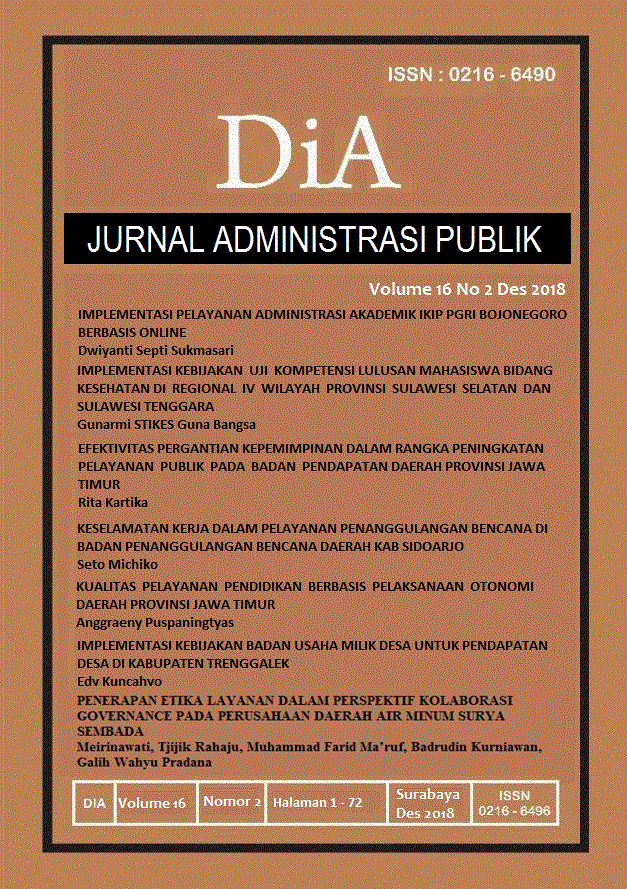KESELAMATAN KERJA DALAM PELAYANAN PENANGGULANGAN BENCANA DI BADAN PENANGGULANGAN BENCANA DAERAH KAB SIDOARJO
DOI:
https://doi.org/10.30996/dia.v16i2.1922Keywords:
Occupational Health and Safety, K3, Sidoarjo Regional Disaster Management AgencyAbstract
In accordance with Article 3 of the Minister of Manpower Regulation No. 05/1996, the Disaster Management Agency of the Sidoarjo Regency began introducing Occupational Health and Safety (K3) activities starting with introducing K3 management in 2000 who had obtained SMK3 certification. During the process of using internal auditors, companies also use external auditors every 3 years with fairly good results. This research is phenomenology using quantitative methods. The Number of samples in this studied 55 employees from the Sidoarjo Regional Disaster Management Agency population. From Knowledge Management variables, the Attitudes and Subjective Norms together towards Intentions were found to be 85.2%. While the remaining 14.8% is influenced by other variables not examined in this study, every increase in Knowledge Management (X1) of 1 unit, it will increase Intention (Y) by 0.325 units. Every increase in Attitude (X2) of 1 unit, it will increase Intention (Y) of 1,116 units. Each increase in Subjective Norms (X3) is 1 units, it will increase Intention (Y) by 0.203 units.Downloads
References
Azhary, Muhammad Tahir, Negara Hukum Indonesia, UI Press, Jakarta, 1995.
Basah, Sjachran, Beberapa Hal Tentang Hukum Acara Administrasi, Kerjasama Indonesia-Belanda, Bandung, 1987.
_____, Eksistensi dan Tolak Ukur Badan Peradilan Administrasi Di Indonesia, Alumni, Bandung, 1997.
_____, Hukum Acara Pengadilan Dalam Lingkungan Peradilan Administrasi (HAPLA), Rajawali Pers, Jakarta, 1992.
Efendi Lotulung, Paulus, Hukum Tata Usaha Negara Dan Kekuasaan, Salemba Humanika, Jakarta, 2013.
_____, Lintasan Sejarah dan Gerak Dinamika Peradilan Tata Usaha Negara (PERATUN) Di Mata Paulus Effendi Lotulung, Salemba Humanika, Jakarta, 2013.
Esparraga, Frank, Developments in European Administrative Law. In Administrative Law under the Coalition Government, Edited by John McMillan, Published in Canberra by Australian Institute of Administrative Law Inc, 1998.
Fachruddin, Irfan, Pengawasan Peradilan Administrasi Terhadap Tindakan Pemerintah, PT. Alumni (Anggota IKAPI), Bandung, 2008.
Hadjon, Philipus M., dan Tatiek Sri Djatmiati, Hukum Administrasi dan Tindak Pidana Korupsi, Gadjah Mada University Press, Yogyakarta, 2011.
_____, Pengantar Hukum Administrasi Indonesia (Introduction The Indonesian Administration Law), Gadjah Mada University Press, Yogyakarta, 1993.
_____, Perlindungan Hukum Bagi Rakyat, Bina Ilmu, Jakarta, 1987.
Hamzah, Andi, Asas-asas Hukum Pidana Indonesia-Edisi Revisi, Rineka Cipta, Jakarta, 2008.
Heriyanto, Bambang, Dwangsom Dalam Putusan Hakim Peradilan Tata Usaha Negara (Suatu Gagasan), Jakarta, 2004.
Hufron dan Syofyan Hadi. Ilmu Negara Kontemporer “Telaah Teoritis Asal Mula, Tujuan Dan Fungsi Negara, Negara Hukum Dan Negara Demokrasiâ€, Laksbang Grafika dan Kantor Advokat “Hufron & Rubaieâ€, Yogyakarta, 2016.
Indroharto, Usaha Memahami Undang-undang Peradilan Tata Usaha Negara, Buku I, Beberapa Pengertian Dasar Hukum Tata Usaha Negara, Sinar Harapan, Jakarta, 1993.
_____, Usaha Memahami Undang-undang Peradilan Tata Usaha Negara, Buku II, Beracara Di Pengadilan Tata Usaha Negara, Sinar Harapan, Jakarta, 1993.
Kelsen, Hans, General Theory of Law and State, Russell & Russell, New York, 1973.
Marzuki, Peter Mahmud, Penelitian Hukum, Cet. 6, Kencana Prenada Media Group, Jakarta, 2010.
Mertokusumo, Sudikno, Bab-bab Tentang Penemuan Hukum, 1993, Citra Aditya Bakti, Bandung, 1993.
_____, Hukum Acara Perdata Indonesia, Liberty, Yogyakarta, 1988.
Prodjodikoro, Wirjono, Asas-asas Ilmu Negara dan Politik, Eresco, Bandung, 1971.
Prodjohamidjojo, Martiman, Hukum Acara Pengadilan Tata Usaha Negara dan UU PTUN 2004, Ghalia Indonesia (Anggota IKAPI), Jakarta 2005.
Purbopranoto, Kuntjoro, Perkembangan Hukum Administrasi Indonesia, Binacipta, Jakarta, 1981.
Sadjiono, Bab-Bab Pokok Hukum Administrasi, Laksbang Pressindo, Yogyakarta, 2011.
Zed, M. (2008). Metode Penelitian Kepustakaan. Jakarta: Yayasan Obor Indonesia. Zhou, R., Rau, P.L., Zhang, W., & Zhuang, D., (2012), Mobile Phone Use While
Driving: Predicting Drivers' Answering Intentions and Compensatory Decisions, Journal of Safety Science, Vol. 50, pp. 138-149
Downloads
Published
How to Cite
Issue
Section
License
The DiA journal allows authors to retain the copyright of their papers without limitation. Authors may grant publishers non-exclusive publishing rights to publish articles. Granting first publishing rights to publishers also qualifies as unlimited copyright (because there are no restrictions imposed by publishers on author copyright).






